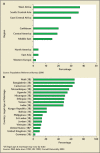Child marriage: a silent health and human rights issue
- PMID: 19399295
- PMCID: PMC2672998
Child marriage: a silent health and human rights issue
Abstract
Marriages in which a child under the age of 18 years is involved occur worldwide, but are mainly seen in South Asia, Africa, and Latin America. A human rights violation, child marriage directly impacts girls' education, health, psychologic well-being, and the health of their offspring. It increases the risk for depression, sexually transmitted infection, cervical cancer, malaria, obstetric fistulas, and maternal mortality. Their offspring are at an increased risk for premature birth and, subsequently, neonatal or infant death. The tradition, driven by poverty, is perpetuated to ensure girls' financial futures and to reinforce social ties. One of the most effective methods of reducing child marriage and its health consequences is mandating that girls stay in school.
Keywords: Child marriage; Early marriage; Maternal mortality.
Figures




References
-
- Mathur S, Greene M, Malhotra A. Too Young to Wed: The Lives, Rights and Health of Young Married Girls. Washington, DC: International Center for Research on Women; 2003. pp. 1–15.
-
- United Nations, authors. World Marriage Patterns. New York: United Nations Population Division, Department of Economic and Social Affairs; 2000.
-
- Population Reference Bureau, authors. The World’s Youth 2006 Data Sheet. Washington, DC;: Population Reference Bureau; 2006. [Accessed February 25, 2009]. http://www.prb.org/pdf06/WorldsYouth2006DataSheet.pdf.
-
- Alan Guttmacher Institute, authors. Into a New World: Young Women’s Sexual and Reproductive Lives. New York: Alan Guttmacher Institute; 1998.
LinkOut - more resources
Full Text Sources
